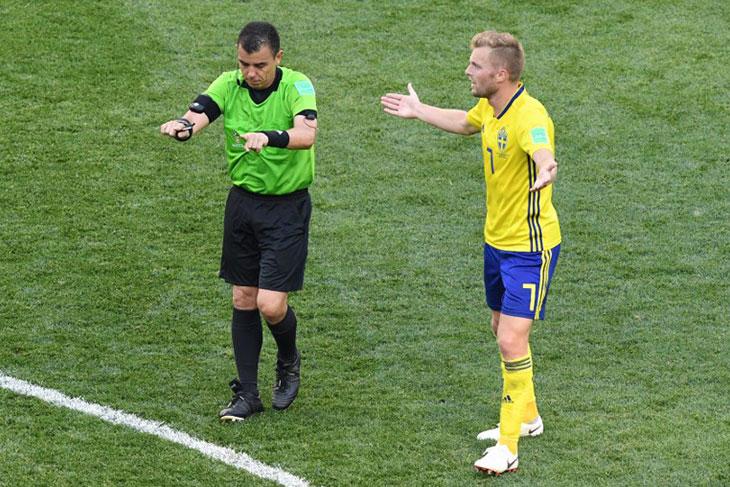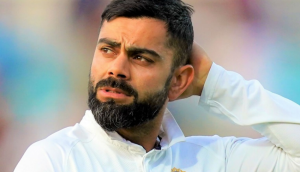VAR, like many big teams at the World Cup, blows hot and cold

Besides Iceland and Panama, there's one another World Cup debutant that's causing a bit of a stir in Russia. The Video Assistant Referee, or VAR, has perhaps snatched the limelight from all the big teams and big names at the World Cup. After much deliberation, debate and trial, VAR has finally arrived at the big stage, and the reaction to it, unsurprisingly, has been mixed.
VAR has been the topic in the meeting room for ages now. But before even talking about VAR, we need to talk about referees. Yes, those tireless officials who make a football game tick, who train and work harder than we could imagine, whose salaries are astronomically lower than players and managers; the same who criticise them after every game.
A referees' decision is always under intense scrutiny from players, managers, pundits, experts and fans. We all have been there, screaming "that was a foul!", or "how was that not a penalty?", concluding sometimes, in the extreme case, "the referee's sold out." Every decision given, or not given, becomes a personal affront, a grave injustice done against your team.
Some managers do refrain from picking on referees after the game, but most feel free to use the 'referee excuse' after an undesirable result, even though punishments are reserved for going too far. A recent extreme example must be fresh in everyone's mind. After being sent off by referee Michael Oliver for showing aggressive disapproval for a late penalty call in their Champions League quarter-final defeat to Real Madrid, Juventus goalkeeper Gianluigi Buffon called Oliver "an animal" after the game.
In his tirade, Buffon went on to say that Oliver had "a rubbish bin instead of a heart" and that he had committed "a crime against sportsmanship". The situation turned uglier when in the following days, Oliver and his wife received online abuse and death threats from Juventus fans. Buffon later offered an apology and was banned by UEFA for three games for his indiscretion.
Referees have a better strike rate than any forward in the game
Oliver's decision was right. In fact, most referee decisions are. Despite the din after literally every game, the numbers say that referees have better strike rate than any forward in the game. Sky Sports crunched a few numbers during their 'Support the Ref' week in March. According to the Professional Game Match Officials (PGMO), a Premier League referee, on an average, makes around 245 decisions per game. About 45 of these are technical decisions like goal-kicks, corners and throw-ins. The rest 200 are decisions over physical contact and disciplinary actions.
Out of the 200, around 35 are visible decisions — the ones we see — where an action is taken, calling a foul or restarting the game. The rest 165 are non-visible — decisions that aren't calls — where play is allowed to continue. It was found that a referee, on an average, made a total of five mistakes, thus making their decisions right 98 percent of the time. Even assistant referees, whose jobs are probably the toughest in football, are 98 percent accurate in their decisions. It is safe to say that referees do their jobs exceptionally well.
However, the odd wrong decision can sometimes impact the game's outcome and that is troublesome, especially in a big match like a Champions League final or a World Cup knockout game. The push for technology to aide referees has been debated for long. Referees were making too many decisions, why not make their job easier?
First goal-line technology and then VAR
Goal-line technology rules out the shot from Isco #POR #esp pic.twitter.com/tnE11dkQ68
— Jan ter Harmsel (@dutchreferee) June 15, 2018
In 2012, International Football Association Board, or the IFAB, approved goal-line technology and it has since been used in all top European leagues and international matches with great success. But making a binary decision based on visual fact, the truth of something as simple as whether the ball crossed the line or not, is simple and non-controversial. The VAR, on the other hand, deals with complex judgments and calls, assessing every technicality and complexity of the applicable rule, to give huge decisions that can change the course of the game. And that's when controversy comes calling.
After extensive trials, the IFAB wrote VAR permanently into the Laws of the Game on 3 March and on 16 March. FIFA, at a General Council meeting, officially approved the use of VAR at the World Cup. VAR already had faced vocal opposition during its trial run. Even before the trials, when it was being debated, numerous football professionals and fans had opposed it, saying it would interfere with the game and break the flow. That its over reliance would kill football's spirit. But now VAR was to feature at the game's biggest stage.
The VAR handbook
Before delving into VAR at the World Cup, it would be wise to check out the fundamentals of VAR. Now, there's a 67-page IFAB VAR implementation handbook for competitions available on the Dutch football association website, with a couple of other extensive documents on VAR available on the IFAB website itself. The handbook begins, after a brief introduction, with a statement:
"The aim of the experiment is NOT to achieve 100% accuracy for all decisions as there is no desire to destroy the essential flow and emotions of football which result from the game’s almost non-stop action and the general absence of lengthy stoppages. The philosophy is: minimum interference - maximum benefit."
The rules limit the usage of VAR to four categories: goals, penalty/no penalty decisions, direct red cards (not second yellow cards), and mistaken identity in awarding a card.
Then, there are 12 underlying principles that govern VAR. One of the key ones is that final decision will always be taken by the on-field referee.
Another one is that that the referee must always make a decision. Unlike cricket, where umpires, in case of a tricky decision, straightaway signal to the third umpire to check the video footage and deliver the decision, the referee here cannot defer the decision to VAR. He must make a decision. His decision, however, can be reviewed as and when needed according to the rules.
Only the referee can initiate a review process; the VAR and other match officials can only recommend a review to the referee.
Another important one is that accuracy is more important than speed. Yes, it might cause longer than usual stoppages, but the decision delivered must be correct.
Players and team officials must not surround the referee or attempt to influence if a decision is reviewed, the review process or the final decision. A player who uses the ‘review signal’ will be cautioned (yellow card).
And of course, there is a maximum period before and after an incident that can be reviewed.
VAR at the 2018 World Cup

The VAR made its debut in the biggest game of the World Cup so far: Portugal vs Spain. Diego Costa became the first player at the World Cup to be awarded a goal through VAR.
1. Spain vs Portugal
In the build-up to his goal, he appeared to have fouled Portuguese defender Pepe. Italian referee Gianluca Rocchi gave the goal after consulting the VAR team and deeming the challenge fair. The process was swift and barely took any time. However, goalscorer Costa had some words on the incident. "I don't like it (VAR). Not for that, not for the fighting. The other day I scored a goal but I didn't know whether to celebrate or not. If there is a questionable part of the play, you don't celebrate. It can make you look stupid."
2. France vs Australia
Then VAR then made history when it awarded its first penalty decision to France's Antoine Griezmann against Australia. Griezmann was through on goal when Joshua Risdon brought him down in the box. VAR suggested the referee that he should review the decision after he had waved play on and upon review, the challenge was deemed unlawful. France were awarded a penalty, which Griezmann had no trouble converting.
The contact from Risdon was minimal, but it was there and it looked to have stopped Griezmann in a scoring position. So the decision seemed correct. But the problem is that VAR rules state that a review must only be taken in case of "clear and obvious" error. It is debatable that the referee's "error" was "clear and obvious". The subjectivity of referee's judgment over a foul came into play in just the next match between Argentina and Iceland.
3. Argentina vs Iceland
Argentina's Cristian Pavon went down in the box after a challenge fra om Birkir Saevarsson. However, the referee didn't call it a foul and play continued without a review. Upon seeing the incident a second time, one could say that it was clearer penalty than the one awarded to Griezmann. Later in the game, Argentina did receive a penalty, but as fate would have it, Lionel Messi missed it.
4. Denmark vs Peru
Then, again on the same day, when Peru took on Denmark, Yussuf Poulsen appeared to foul Peru's Christian Cueva in the box. It looked like a clear foul and referee seemed to have missed it. VAR suggested a review and the play was stopped. The decision was quick, the referee awarded a penalty to Peru, which Cueva missed. Poulsen went on to score the game's solitary goal and Denmark won.
5. Serbia vs Costa Rica
The next day, during Costa Rica vs Serbia, there was a red card review against Serbia's Aleksandar Prijovic. The referee saw the footage and awarded Prijovic a yellow card.
6. Brazil vs Switzerland
Then the same day there was some VAR controversy in Brazil vs Switzerland. In the build-up to the Swiss equaliser, the goalscorer appeared to have fouled Brazilian defender Miranda. Later, Gabriel Jesus too appeared to have been fouled in the box in a grappling incident. No review was taken in either of the incidents and Brazil have in fact sought clarification from FIFA over the use, or rather non-use, of VAR in the game.
7. South Korea vs Sweden
VAR again was back in play the next day when Sweden faced South Korea in Group F. Kim Min-Woo's challenge on Sweden's Viktor Claesson in the box looked like a clear foul but the referee continued play. VAR quickly suggested a review and — here's the troubling bit — the referee stopped the play when South Korea had started a counterattack. Upon viewing video evidence, the referee awarded a penalty to Sweden. It was a correct decision, but the implementation was suspect.
According to the laws, the review should be taken when the ball is in a neutral area or has gone out of play to not interfere with the game. This controversy was nothing compared to the one that became a talking point after the Group G game between England and Tunisia.
8. England vs Tunisia
First, VAR upheld a decision to award Tunisia a penalty when Kyle Walker fouled Fakhreddine Ben Yussef in the box. It was a contentious one, but the referee had awarded a penalty initially and his decision didn't seem like a "clear and obvious error", so it was fine. But then Harry Kane was denied two penalty claims, both of which looked clear fouls inside the box, the VAR team did not suggest the referee to review the decisions. Following criticism, FIFA has said that it will analyse whether VAR was wrong in not advising a review.
9. Egypt vs Russia
The latest VAR incident came last night when Egypt's Mohamed Salah was brought down near the box and the referee initially gave a free-kick. However, VAR intervened and told the referee to award a penalty to Egypt as the foul had occurred inside the box.
Inconsistency in implementation of VAR
As more games take place, more VAR incidents and decisions will come into play and some of them will surely be controversial. However, until now, barring a couple of contentious occasions, VAR has mostly given the correct decision (within the subjective realm of the word "correct").
The implementation, however, does remain a bit suspect. And there is a clear impact as well. The Telegraph found that average penalties per game in the World Cup, which stands at a staggering 0.56 at this stage, is the highest since 1966. To compare, at this stage, there were only 0.06 penalties per game in the 2006 and 2010 World Cups. That means a penalty is being awarded faster than a rate of one every two games. VAR also seems to have some unintended and less apparent consequences. A referee's judgment is subjective on calls like fouls in the box. That is not to say it is wildly erratic. It is based on IFAB rules. But often a 'soft foul' in the box, which might still technically be a foul, is not penalised.
The referee, in his experience and sound judgment, may feel that the player fell down too deliberately and easily, even though there was contact from the opposition. He might not award a penalty that could change the game. VAR, however, seems to bypass that. If, and this is somewhat subjective too, the VAR team feels that an incident in the box is worthy of a review and suggests the same to the on-field referee, a technical albeit soft foul reviewed over video could turn into a penalty decision. There could also be contention about the phrase "clear and obvious" and which refereeing errors come within its gamut.
At the World Cup, the biggest problem seems to be the consistency in VAR implementation. When it is to be used and when it is not to be used, is causing confusion among fans. And of course, the debates about interfering with the flow of the game and causing stoppages will always be there. There is no consensus. This is VAR's first World Cup and even after a long period of trials, it was bound to court some controversy. A final verdict should be reserved until the end of the tournament and changes and modifications can be debated and implemented as needed. For now, like many big teams at the World Cup, VAR seems to be blowing hot and cold.
First published: 20 June 2018, 18:03 IST





![BJP's Kapil Mishra recreates Shankar Mahadevan’s ‘Breathless’ song to highlight Delhi pollution [WATCH] BJP's Kapil Mishra recreates Shankar Mahadevan’s ‘Breathless’ song to highlight Delhi pollution [WATCH]](https://images.catchnews.com/upload/2022/11/03/kapil-mishra_240884_300x172.png)

![Anupam Kher shares pictures of his toned body on 67th birthday [MUST SEE] Anupam Kher shares pictures of his toned body on 67th birthday [MUST SEE]](https://images.catchnews.com/upload/2022/03/07/Anupam_kher_231145_300x172.jpg)






